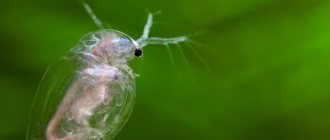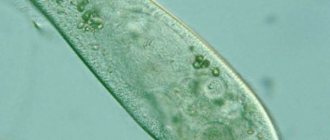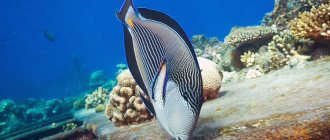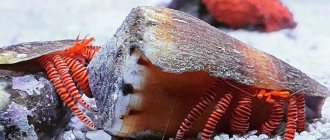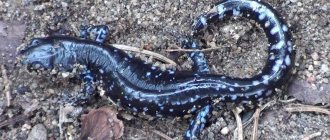Stingrays are one of the oldest fish. Habitat: fresh and salt waters. Stingrays are found all over the planet: in tropical, subtropical, and also off the coast of Antarctica.
In tropical latitudes, stingrays live in small sizes up to 15 cm; Cook's Stingray has an average size, about 5 meters. The sea devil is the largest representative of the Stingrays, reaching 7 m in width, weighing 3.5 tons. Let's look at the main characteristics of the superorder of stingrays.
Description
The stingray has a flat, elliptical body shape that ends with a tail. The fused pectoral fins look like wings, as can be seen in the photo.
According to characteristics, the average size of the fish is up to 50 cm, but there are also large specimens that reach 1.2 m in length and weigh up to 100 kilograms. Convex eyes are clearly visible on the animal’s head, and vision is quite developed. The respiratory organs, the squirters, are located in the same place as the eyes of the stingray.
There are some species that lack vision. These are mainly deep-sea representatives. For them, this function is replaced by electroreception - the susceptibility of even weak electrical impulses that generate living organisms.
“The location of the visual organs physically does not allow the fish to see what it eats.”
The gills and mouth opening are located at the bottom of the body. During breathing, the squirts are involved in the flow of water to the gills, which exits through the gill slits. Breathing is thus determined by bottom dwelling. Swallowing water with its mouth, like a shark, various soil components and sand would affect the delicate respiratory organs. Accordingly, the intake occurs from above, and the water coming out through the gills disperses the sand, helping to search for prey.
The organs that generate electricity are located on both sides of the body in the interval from the head to the pectoral fins. These bodies are designed for effective self-defense and productive fishing. Discharges can be up to 220V. Find out other equally interesting facts about stingrays.
The color is largely influenced by the color palette of the immediate habitat. This can range from a discreet appearance to bright, fancy patterns.
The main function of the stingray's color is camouflage for catching prey or hiding from predators. Representatives of all species are solitary and can form groups solely for reproduction.
Features of character and lifestyle
Photo: What a stingray looks like
All stingrays are characterized by a solitary lifestyle. As mentioned above, they prefer to quietly spend the daytime, lying on the bottom or burying themselves in the sand. During moments of rest, they scan the surrounding area using electroreception, identifying potential prey or an enemy. Using the same method, they are able to communicate with each other, transmitting and picking up electrical signals, like bats.
This ability is well developed in all stingrays. Fish hunt and actively swim at night, it is then that they rely most on the perception of electrical signals, since even those whose vision is not reduced, it is not clear enough and cannot fully convey the whole picture of the environment, especially in the dark .
In the water column, stingrays move smoothly, as if floating in the water; unlike sharks, they do not need to scurry quickly to maintain breathing. Movement occurs due to synchronized flapping of the pectoral fins, or so-called wings. Thanks to their flat shape, they do not have to expend much effort to find their way through the water. Despite their slowness, stingrays are able to swim quickly, especially when escaping from a predator.
Some species have small pectoral fins and the fish move by pushing their powerful tail. Another method of movement is the sharp release of a stream of water from the nostrils located on the ventral side, which allows the stingray to make a circular movement in the water column. With this maneuver, he scares away potential predators, but if he approaches him, an additional protection becomes a discharge of electricity.
Animal or fish
Animals can be called all creatures that have a cell structure with heterotrophic nutrition, regardless of their habitat. In taxonomy, the taxon (group) “Animals” is one of the four kingdoms and the creatures included there are quite diverse.
Fish, in taxonomy, are a smaller group and there are fewer creatures included in it than in the animal kingdom. The characteristics that unite these creatures are much greater than those that unite into a kingdom. The main ones are:
- breathing through gills;
- aquatic habitat.
It turns out that from a biological point of view, stingrays are animals, and from a systematic point of view, they are fish. These two concepts are equally valid for them.
They lived at the same time as dinosaurs
In 2021, a team from the Institute of Paleontology at the University of Vienna discovered a fossilized stingray over 50 million years old. The study provides new links to radiation caused by the effects of the Cretaceous mass extinction. Further molecular evidence suggests that modern rays diverged from their sister group during the Late Jurassic, about 150 million years ago. ()
Sebastian Condrea/Getty Images
Where do they live?
These are mainly bottom dwellers. Stingrays are settled where creatures from their main diet live, these are: bays, deep seas, on reefs, near sandy beaches. Some species dive to a depth of 1000 meters. The electric stingray fish is found in seas and oceans with tropical and temperate climate zones.
The geographical scope of their settlement is extensive. Due to its adaptability to a wide range of temperatures (from 3 to 35 degrees Celsius), it lives in almost all saline water basins on the globe.
“Some species even live in Arctic waters, where the water temperature is 1.5-2°C.”
Most stingrays have such a feature as inactivity. Some species of stingrays prefer to wait for prey by burying themselves in the sand and leaving only their eyes on the surface.
Another species settles on a rocky bottom or coral reef and blends into the terrain due to its perfect camouflage.
Home maintenance
Some small species of stingrays can be kept in an aquarium. The volume of the container must be at least 250 liters. For these inhabitants it is better to choose a horizontal dwelling. The bottom should be as free as possible so as not to interfere with the movement of the individual.
You can plant plants in the ground. The aquarium must be closed with a lid , as some individuals like to jump out of the water. They adapt to any water hardness, the main thing is not to change the parameters suddenly.
At home, the pet is fed lake bloodworms . It is first disinfected and frozen. Boiled shrimp are given as a treat. They are sold in grocery stores. They are first cleaned of their shell and legs. Large pieces should be torn into small pieces. It is acceptable to include soft squid and scallops in your diet.
Stingrays can be kept at home
For better formation of dental plates and cartilaginous skeleton, pollock fillet is given. It is a source of phosphorus.
You can try breeding stingrays at home. In males, paired genital organs in the form of tubercles are clearly visible on the lower part of the body. In the female they are in the form of tubes. It is better to place a couple of individuals in a separate aquarium. They are fed generously. Before the breeding process itself, food is not given for four days.
The male will begin to show interest in the female. He will start chasing her and swimming around her beautifully. Sexual intercourse lasts about three minutes. Pregnancy lasts about 20 weeks. Before giving birth, a female will notice a bulge on her lower body.
From one to twelve full-fledged cubs are born; it is better to transplant them into a separate aquarium. Juveniles are fed with tubifex, bloodworms, and small minced fish. They reach sexual maturity by one year of age.
Predator or not
This class of cartilaginous fish is classified as predatory, although it may not look like one. Sharks and rays have such a feature as the presence of 3-4 rows of teeth. Their diet may include both fresh meat and carrion. They get food using weapons given by nature, in this case electricity. Having caught up with the prey, the stingray covers it with its fins and releases a discharge, stunning it, after which it eats.
Signs of defeat
The sting of the stingray's spine is impossible not to notice. The penetration of dangerous poison into the body and rupture of the skin is accompanied by the following unpleasant manifestations:
- Extreme pain.
- Redness of the skin.
- Swelling at the injection site.
- Inflammation of the lymph nodes.
- Increased breathing.
- Slowing heart rate.
- Heart failure.
Important! When affected by a stingray, general signs of intoxication appear. The most characteristic symptoms are vomiting, decreased blood pressure and profuse sweating.
Electrocution damage manifests itself in the form of disturbances in cardiac activity and breathing. After the shock, there may also be redness and pain at the site of impact and a state of shock. If a person loses consciousness after the blow, then death by drowning is possible.
Structure
These creatures have certain structural features. Like sharks, rays are unusual bony fish. Thus, the skeleton of these fish consists entirely of cartilage - this explains the formation of a separate class and name for them. Since they do not have gill covers, the slits open into a separate opening. The diversity of structure can be observed in appearance. The body size varies from 10 centimeters to 10 meters with a mass of 10 tons.
Where are the eyes
In all species, the eyes are located on the upper part of the body. This anatomical feature causes mediocre vision in these fish. Eye size ranges from small to large. In the diet of these creatures, vision is not the leading organ.
“A species like the blind electric ray has its eyes completely covered by skin.”
Sea devil tastes good
They say that its meat is not only tasty, but also nutritious. In ancient literature you can find descriptions of recipes with sea devil. But hunting this stingray is far from safe and difficult. Due to its size, the sea devil can easily, for example, overturn a boat. And why kill this extraordinary creature of nature, especially considering the fact that the female brings only one cub. True, the size of the latter is very, very impressive, as is the weight, which on average at birth is ten kilograms.
What does it eat?
They are predominantly nocturnal and prefer to feed in the dark. What stingrays feed on can be found in abundance in shallow waters or reefs, these are mollusks, small fish, arthropods, plankton, etc. Large individuals can prey on mullet, salmon and sardines. Stingrays have mouths that expand when they eat, this allows them to swallow fairly large catches.
Units
Most species of stingrays lead a bottom-dwelling lifestyle and feed on mollusks and crayfish. Pelagic species consume plankton and small fish. Let's figure out which groups scientists distinguish:
- electrical;
- sawfish;
- slope-shaped;
- tail-shaped.
Various types of stingrays can be found in various places around the globe. They are found in Antarctica and the Arctic Ocean. If you want to see a flying stingray with your own eyes, then go to the coast of Australia, there are more than enough of them. The most diverse types of stingrays, photos of which are presented in this article, fully reveal the entire history of their existence and modern life.
How are stingrays born?
These cartilaginous fish are dioecious. Their reproductive system has a complex structure. Stingrays can be viviparous, ovoviviparous, or ovoviviparous.
- Viviparous. All stages of development occur in the mother’s body, after which, as the name implies, a fully formed individual is born. Development and birth occur while being twisted into a tube. This is the only way they fit in the uterus. The stingray feeds the embryo through “villi”, through which the necessary substances are supplied.
- Ovoviviparous. When born using this method, the embryos located in the uterus are in a hard shell. The shell contains nutrients that are vital for the embryo and its development. The entire maturation stage takes place in the eggs. The female stingray protects and bears them until birth.
- Ovoparous. With this option, the female lays eggs, which are secured with the help of cords on parts of the substrate.
Hatched or recently born fish are quite ready to produce electricity. The offspring are perfectly adapted to survival, and, thanks to this, different species reproduce different numbers of embryos, but no more than 10. Stingrays have pronounced sexual dimorphism. Sexual maturity occurs when the fish grows to the required size. Certain species can breed when females reach 35-40 cm and males 20-30 cm.
They move by flapping their "wings"
Stingrays may look like they are flying through the water, but upon closer inspection you will notice the graceful flapping motion that propels them. Most species make undulating movements with their bodies, moving like an underwater wave, but others tend to flap their sides up and down like wings. A study conducted by the Save Our Seas Foundation found that stingrays native to South Africa move at speeds of 1.35 kilometers per hour, and some species have migrated up to 850 kilometers. ()
Kinds
Stingrays, along with sharks, which are their close relatives, are the oldest animals inhabiting the aquatic kingdom. They belong to cartilaginous fish, the superorder of elasmobranchs, numbering 5 orders, as well as 15 families.
Scientists identify the following types of stingrays:
- tail-shaped;
- electrical;
- slope-shaped;
- Sawtooth-like.
“Any stingray is considered an electrical creature, since all of them can generate current. But only the sea stingray is capable of producing it with a voltage of 220 volts.”
These creatures, numbering 69 varieties, are grouped into the following families:
- bracken These are large creatures that live in the pelagic region. They can be found most often in the open waters of the seas. They prefer tropical waters. They move in waves by flapping their wings-fins;
- narcinaceae. Benthic, measured creatures. They can produce a current no more powerful than 40 volts. They are found in temperate latitudes, living in river mouths, sandy bays and reefs;
- nasal. There are forty species. They move slowly, often just lying on the bottom, buried in the sand. When prey swims nearby, the stingray stuns it and eats it;
- sawflies. There are 7 types. They have a shark tail and a certain external resemblance to the latter. They prefer tropical latitudes. Their main diet consists of schooling fish. They crash into the school and wield the saw like a sword, after which they pick up the remains from the bottom. Not dangerous to humans;
- stingrays. The body of these fish is completely covered with spines. At the end of the tail there are secretions that secrete poison, which is why a blow from the tail can be deadly. Having penetrated the body, the poison provokes tachycardia, reduces blood pressure, causes vomiting and leads to paralysis;
- guitar This species has a shark-like appearance, but the presence of gills makes them stingrays. Movement occurs with the help of the tail, like a shark. The diet includes shellfish and small fish. They attack their prey from above, pressing it to the bottom.
Nutrition
Based on the way they eat, they can be called large “filters.” Between their gill arches there are spongy beige-pinkish plates, which are a device for filtration. Their main food is zooplankton and fish eggs. Small fish may also be caught. They travel long distances in search of areas of plankton suitable for nutrition. They find these places using sight and smell.
Each week, one manta ray is able to consume an amount of food that is approximately 13% of its own weight. If our fish weighs 2 tons, that means he consumes 260 kg of food every week. It circles around the selected object, gradually compacting it into a ball, then accelerates and makes a final through swim with its mouth open.
At this time, those same head fins provide invaluable assistance. They instantly unfold from spiral horns into long blades and begin to “shovel” food into the host’s mouth. Sometimes they hunt in a whole group. In this case, they have a very remarkable moment in the process of obtaining food.
Manta rays feed on plankton and can consume up to 17 kg of it per day
A group of stingrays line up in a chain, then close in a circle and begin to quickly circle around the carousel, creating a real “tornado” in the water. This funnel pulls plankton out of the water and holds it captive. Then the stingrays begin the feast, diving inside the funnel for food.
How many volts does it produce?
The organs that produce electricity are similar to the human kidney. The stingray has two such organs. The current is produced through muscle contractions. The resulting energy is accumulated and stored in these two organs like a battery. The electricity itself can spread from the body itself, and not from some part of it, and can plunge the victim into a serious electric shock.
An adult stingray, also fully charged, creates an electric shock with a power of 220 volts. This force is enough to make an adult lose his balance, but not enough to kill. Although, if there are problems with internal organs, theoretically, a stingray with such power can kill. Death can also occur if a person or prey loses consciousness, is in shock or is injured and therefore is unable to move normally and, as a result, drowning.
The stingray uses its electrical capabilities only for protection or as a hunting weapon. These creatures seem to be slow or poor swimmers, but their lightning-fast short-distance dash allows them to quickly catch up with their prey and shock it. If he manages to get quite close to the fish, he wraps his wings around it before stunning it. This allows him to perform a series of electric shocks, which is guaranteed to kill the victim.
“In areas where stingrays are abundant, local residents use the fish to treat arthritis by giving them a series of shocks.”
The charge is formed due to muscle contractions, and the two organs that accumulate it can equal 20% of the entire mass of the stingray. Stingrays can be considered harmless to people, even friendly. If their meeting does occur, the fish creates a weak discharge as a warning. Scientists believe that they have 2 blows: a weak and short-lived one for warning and a powerful blow to kill the attacker or prey.
Interesting Facts
- Sometimes the aquatic “flight” of a majestic stingray can turn into a real aerial one. It actually soars above the surface of the sea, making something like a jump to a height of up to 1.5 m. It is not clear why this happens, but the spectacle is truly magnificent. There are several assumptions: this is how he tries to get rid of parasites on his body, or exchanges signals with other individuals, or drowns out the fish by hitting the water with his powerful body. At this moment it is undesirable to be near him, he can turn the boat over.
- If a manta ray wanted to, it could easily hug a whale shark, the largest fish in the world, with its fins. For such a scope and size of its fins it is considered the largest stingray in the ocean.
- Divers spending time in the Indian Ocean talked about how they found themselves in a piquant situation. A giant stingray swam up to them, interested in the bubbles of water from the scuba tank, and tried to lift them to the surface. Maybe he wanted to save the “drowning”? And with his “wings” he lightly touched the person, as if inviting him to stroke his body in return. Perhaps he liked being tickled.
- Manta rays have the largest brains of any fish known to date. It is possible that they are the “smartest” fish on the planet.
- Only five aquariums in the world can boast of having manta rays among their marine pets. It is so large that it requires considerable space to maintain it. In one of these institutions operating in Japan, a case of the birth of a small stingray in captivity was recorded.
- In mid-May 2021, a giant manta ray turned to people off the coast of Australia for help. The divers saw a large stingray that persistently attracted their attention by swimming around them. Finally, one of the swimmers saw a hook stuck in the animal's body. People had to dive to the victim several times, all this time the colossus patiently waited for them to pull out the hook. Finally, everything ended well, and the grateful animal allowed itself to be stroked on its belly. A video of him was posted on the Internet, the hero was called Freckles.
Other uses[edit]
Stingray Wallets
Stingray skin is used as a bottom
layer for the cord or leather wrap (known as
Samegawa
in Japanese) on Japanese swords due to its hard, rough texture of the leather, which prevents the woven film from sliding over the hilt during use.
They are also used to make exotic shoes, boots, belts, wallets, jackets and cell phone cases. [ citation needed
]
Several ethnology sections in museums [46], such as the British Museum, display arrowheads and spear points made from stingray stingers, used in Micronesia and elsewhere. [47] Henri de Monfreid stated in his books that before World War II, in the Horn of Africa, whips were made from the tails of large stingrays, and these devices caused brutal cuts, so in Aden, the British banned their use on women and slaves. In the former Spanish colonies, the stingray is called raya látigo
(“
braided
slope”).
Links[edit]
- ^ ab Nelson J.S. (2006). Fishes of the World
(fourth ed.). John Wiley. pp. 76–82. ISBN 978-0-471-25031-9. - Helfman GS, Collette BB, Facey DE (1997). Variety of fish
. Blackwell Science. p. 180. ISBN 978-0-86542-256-8. - Bester S, Mollett WC, Bourdon J (2017-05-09). "Pelagic stingray". Florida Museum of Natural History, Division of Ichthyology.
- The Future of Sharks: Review of Actions and Inactions CITES AC25 Inf. 6, 2011.
- "IUCN Red List". International Union for Conservation of Nature. Archived from the original on June 27, 2014.
- Carrier JC, Musick JA, Heithaus MR (2012-04-09). Biology of sharks and their relatives (Second ed.). CRC Press. ISBN 9781439839263.
- Jump up
↑ Khanna, D. R. (2004). Biology of Fishes. Discovery Publishing. ISBN 9788171419081. - Kohlmann, M.A.; Crofts, S. B.; Dean, Minnesota; Summers, A.P.; Lovejoy, North Carolina (November 13, 2015). "Morphology does not predict performance: Jaw curvature and prey crushing in durophagous rays". Journal of Experimental Biology
.
218
(24):3941–3949. DOI: 10.1242/jeb.127340. PMID 26567348. - Kajiura, zero; Tricas, NULL (1996). "Seasonal dynamics of dental sexual dimorphism in the Atlantic ray Dasyatis sabina". Journal of Experimental Biology
.
199
(Pt 10): 2297–2306. ISSN 1477-9145. PMID 9320215. - "Stingray". bioweb.uwlax.edu
. Retrieved May 12, 2021. - Kardong K (2015). Vertebrates: comparative anatomy, functions, evolution
. 2 Penn Plaza, New York, NY 10121: McGraw-Hill Education. item 426. ISBN. 978-0-07-802302-6.CS1 maint: location (link) - Bedore CN, Harris LL, Kajiura SM (April 2014). "Behavioral responses of bats to simulated prey electrical fields correlate with peripheral sensory morphology and ecology." Zoology
.
117
(2):95–103. DOI: 10.1016/j.zool.2013.09.002. PMID 24290363. - ↑
Stingray City - Changing the behavior and physiology of stingrays? . Divephotoguide.com (April 14, 2009). Retrieved July 17, 2012. - Tricas TC, Michael SW, Sisneros JA (December 1995). "Electrosensory optimization for phase-matched signals for mating." Neuroscience Letters
.
202
(1–2): 129–32. DOI: 10.1016/0304-3940 (95) 12230-3. PMID 8787848. S2CID 42318841. - Frequently asked questions about freshwater stingray behavior. Wetwebmedia.com. Retrieved July 17, 2012.
- Trikas, Timothy S.; Rasmussen, L.E.L.; Maruska, Karen P. (2000). "Annual cycles of steroid hormone production, gonadal development, and reproductive behavior in the Atlantic stingray". General and comparative endocrinology
.
118
(2):209–25. DOI: 10.1006/gcen.2000.7466. PMID 10890563. S2CID 11150958. - Trikas, Timothy S.; Rasmussen, L.E.L.; Maruska, Karen P. (2000). "Annual cycles of steroid hormone production, gonadal development, and reproductive behavior in the Atlantic stingray". General and comparative endocrinology
.
118
(2):209–25. DOI: 10.1006/gcen.2000.7466. PMID 10890563. S2CID 11150958. - Trikas, Timothy S.; Rasmussen, L.E.L.; Maruska, Karen P. (2000). "Annual cycles of steroid hormone production, gonadal development, and reproductive behavior in the Atlantic stingray". General and comparative endocrinology
.
118
(2):209–25. DOI: 10.1006/gcen.2000.7466. PMID 10890563. S2CID 11150958. - Trikas, Timothy S.; Rasmussen, L.E.L.; Maruska, Karen P. (2000). "Annual cycles of steroid hormone production, gonadal development, and reproductive behavior in the Atlantic stingray". General and comparative endocrinology
.
118
(2):209–25. DOI: 10.1006/gcen.2000.7466. PMID 10890563. S2CID 11150958. - Trikas, Timothy S.; Rasmussen, L.E.L.; Maruska, Karen P. (2000). "Annual cycles of steroid hormone production, gonadal development, and reproductive behavior in the Atlantic stingray". General and comparative endocrinology
.
118
(2):209–25. DOI: 10.1006/gcen.2000.7466. PMID 10890563. S2CID 11150958. - Florida Museum of Natural History Division of Ichthyology: Atlantic Ray. flmnh.ufl.edu. Retrieved July 17, 2012.
- Seubert, Curtis (April 24, 2017). “How do stingrays care for their young?” . Quote journal requires |journal=(help)
- "Stingrays are born only in female tanks". Sydney Morning Herald
. 2011-08-10. - Jump up
↑ Wang, Y (2015).
"Design and Experimentation of Biometric Fish Robots Inspired by the Freshwater Stingray." Journal of Bionic Engineering
.
12
(2): 204–216. DOI: 10.1016/S1672-6529(14)60113-X. S2CID 136537698. - Macesic, J (2013). "Synchronized swimming: coordination of pelvic and pectoral fins during enhanced swimming in the freshwater stingray Potamotrygon orbignyi." Zoology
.
116
(3):144–150. DOI: 10.1016/j.zool.2012.11.002. PMID 23477972. - ^ a b c Fontanella J (2013). "2D and 3D geometry of batoids in relation to locomotor mode". Journal of Experimental Biology and Ecology
.
446
: 273–281. DOI: 10.1016/j.jembe.2013.05.016. - Jump up
↑ Bottom II, R (2016).
"Hydrodynamics of swimming in stingrays: numerical modeling and the role of the leading vortex" (PDF). Journal of Fluid Mechanics
.
788
: 407–443. DOI: 10.1017/jfm.2015.702. S2CID 124395779. - Kolmann MA, Huber DR, Motta PJ, Grubbs RD (September 2015). "Biomechanics of feeding in the sex ray Rhinoptera bonasus during ontogeny". Journal of Anatomy
.
227
(3):341–51. DOI: 10.1111/joa.12342. PMC 4560568. PMID 26183820. - ↑
Dean MN, Bizzarro JJ, Summers AP (July 2007).
"Evolution of cranial structure, diet, and feeding mechanisms in flying fish". Integrative and Comparative Biology
.
47
(1): 70–81. DOI: 10.1093/ICB/icm034. PMID 21672821. - Jump up
↑ Curio E (1976).
The ethology of predation - Springer
. DOI: 10.1007/978-3-642-81028-2. ISBN 978-3-642-81030-5. S2CID 8090692. - Wilga CD, Maia A, S Nauwelaerts, Lauder GV (February 2012). "Prey processing using whole-body fluid dynamics in batoids". Zoology
.
115
(1):47–57. DOI: 10.1016/j.zool.2011.09.002. PMID 22244456. - Kolmann MA, Welch KC Summers AP, Lovejoy NR (September 2016). "Always Chew Your Food: Freshwater Rays Chew Tough Insect Prey". Progress. Biological Sciences
.
283
(1838):20161392. doi:10.1098/rspb.2016.1392. PMC 5031661. PMID 27629029. - Notarbartolo di Sciara G, Hillyer EV (1989-01-01). "Mobulid rays off eastern Venezuela (Chondrichthyes, Mobulidae)". Kopeya
.
1989
(3):607–614. DOI: 10.2307/1445487. JSTOR 1445487. - ^ abc Slaughter RJ, Beasley DM, Lambie BS, Schep LJ (February 2009). "Poisonous Creatures of New Zealand". New Zealand Medical Journal
.
122
(1290): 83–97. PMID 19319171. Archived from the original on April 17, 2011. - "Case Reports of Stingray Injury". Clinical Toxicology Resources
. University of Adelaide. Retrieved October 22, 2012. - Flint DJ, Sugrue WJ (April 1999). "Stingray Injuries: A Lesson in Debridement." New Zealand Medical Journal
.
112
(1086):137–8. PMID 10340692. - “I thought stingrays were harmless, so how did they kill the Crocodile Hunter? » » . September 11, 2006
- Discovery Channel mourns the death of Steve Irwin. animal.discovery.com
- da Silva NJ, Ferreira KR, Pinto RN, Aird SD (June 2015). "Serious accident caused by the ocellated river stingray (Potamotrygon motoro) in Central Brazil: how well do we understand the chemistry of the stingray venom, poisoning and treatment?" . Toxins
.
7
(6):2272–88. DOI: 10.3390/toxins7062272. PMC 4488702. PMID 26094699. - Dos Santos JC, Grund LZ, Seibert CS, Marques EE, Soares AB, Quesniaux VF, Ryffel B, Lopes-Ferreira M, Lima C (August 2021). "Stingray venom activates IL-33-producing cardiomyocytes but not mast cells, promoting acute neutrophil injury". Scientific reports
.
7
(1): 7912. DOI: 10.1038/s41598-017-08395-y. PMC 5554156. PMID 28801624. - ^ ab Pedroso SM, Jared K, Charvet-Almeida P, Almeida MP, Garrone Neto D, Lira MS, Haddad V, Barbaro CS, Antoniazzi MM. (October 2007). "Morphological characteristics of secretory epidermal venom cells in the sting of marine and freshwater stingrays." Toxicon
.
50
(5): 688–97. DOI: 10.1016/j.toxicon.2007.06.004. PMID 17659760. - Enwezor LA, Wilborn RE, Bennett WA (December 2011). "Toxicity and metabolic costs of the Atlantic stingray (Dasyatis sabina) venom delivery system in relation to its role in life history." Journal of Experimental Marine Biology and Ecology
.
409
(1–2):235–239. DOI: 10.1016/j.jembe.2011.08.026. - Delicious and deadly stingray. Nyonya. New York, New York. (Partially from the archive.) . Deep End Dining (September 05, 2006). Retrieved July 17, 2012.
- Weinheimer M. "Dasyatidae Stingrays". Retrieved February 18, 2018.
- ↑
Sullivan B.N.
(May 2009). "Stingrays: dangerous or not?" . Correct blue
. Retrieved July 17, 2012. - FLMNH Department of Ichthyology: Daisy Stingray. flmnh.ufl.edu. Retrieved July 17, 2012.
- Rudis (Smalltooth Stingray) . Iucnredlist.org. Retrieved July 17, 2012.
- https://www.ucmp.berkeley.edu/vertebrates/basalfish/chondrofr.html UCMP Berkeley "Chondrichthyes: Fossil Record"
- Heliobatis radians Fossil remains of a stingray from the Green River. Fossilmall.com. Retrieved July 17, 2012.
